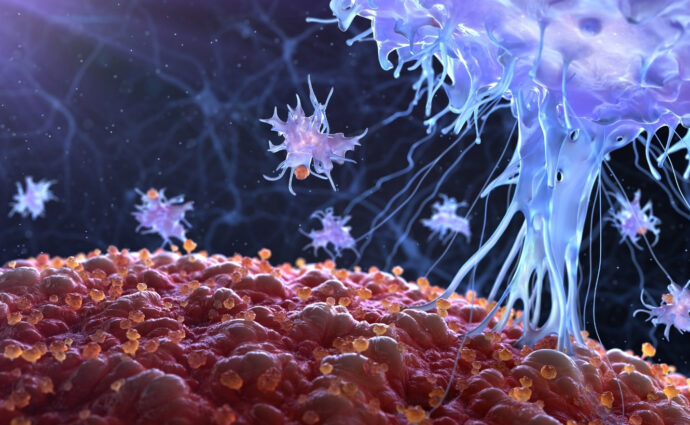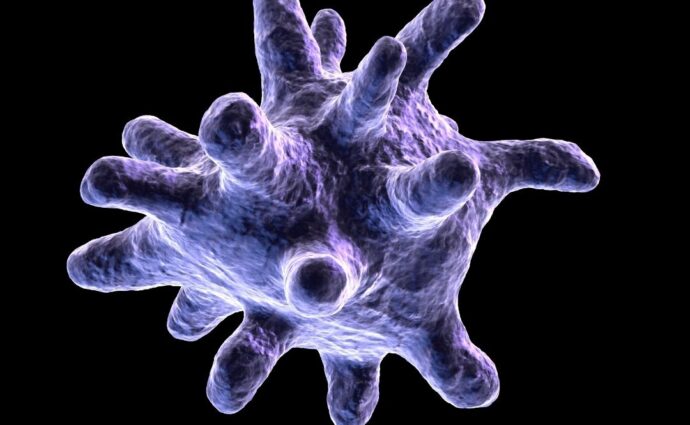Date: May 4, 2021 By:

by: Rachel Leeson. Image credit: Christinelmiller, wikicommons
Ragon scientists discover elite controllers have myeloid dendritic cells that display characteristics of trained innate immune cells
Most discussions around immunity center around the adaptive immune response, the part of the immune system made up of antibodies and T cells that learn to fight specific pathogens after infection or vaccination. But the immune system also has an innate immune response, which uses a set number of techniques to either fight pathogens or support the adaptive immune response.
In the past few years, however, scientists have found that certain parts of the innate immune response can, in some instances, also be trained in response to infectious pathogens, such as HIV. Ragon Core Member Xu Yu, MD, recently published a study in the Journal of Clinical Investigation which showed elite controllers, a rare subset of people whose immune system can control HIV without the use of drugs, have myeloid dendritic cells, part of the innate immune response, that display traits of a trained innate immune cell.
“Using RNA-sequencing technology, we were able to identify one long-noncoding RNA called MIR4435-2HGthat was present at a higher level in elite controllers’ myeloid dendritic cells, which have enhanced immune and metabolic states,” says Yu. “Our research shows that MIR4435-2HG might be an important driver of this enhanced state, indicating a trained response.”
Myeloid dendritic cells’ primary job is to support T cells, which are key to the elite controllers’ ability to control HIV infection. Since MIR4435-2HG was found in higher levels only in cells from elite controllers, Yu explains, it may be part of a learned immune response to infection with HIV. Myeloid dendritic cells with increased MIR4435-2HG also had higher amounts of a protein called RPTOR, which drives metabolism. This increased metabolism may allow the myeloid dendritic cells to better support the T cells controlling the HIV infection.
“We used a novel sequencing technology, called CUT&RUN, to study the DNA of these cells,” says first author Ciputra Hartana, MD, PhD. “It allowed us to study epigenetic modifications like MIR4435-2HG, which are molecules that bind to the DNA and change how, or if, the DNA is read by the cell’s machinery.”
Using CUT&RUN, the team found that MIR4435-2HG might work by attaching to the DNA near the location of the RPTOR gene. The bound MIR4435-2HG would then encourage the cell’s machinery to make more of the RPTOR protein, using the instructions found in the RPTOR gene. This type of epigenetic modification, a trained response to HIV infection, would allow the myeloid dendritic cells to stay in an increased metabolic state and therefore provide long-term support to the T cells fighting the virus.
“Myeloid dendritic cells are very rare immune cells, accounting for only 0.1-0.3% of cells found in human blood,” says Xu Yu. “We were fortunate and thankful to have access to hundreds of millions of blood cells from the many study participants who have donated to support our HIV research. These donations were key to making this discovery.”
Understanding exactly how elite controllers’ immune systems can control HIV is a key part of HIV cure research. If scientists can understand how elite controllers suppress this deadly virus, they may be able to develop treatments which allow other people living with HIV to replicate the same immune response, removing the need for daily medication to control the virus and achieving what is known as a functional cure.
Funding
This work was supported by NIH grants HL134539, AI116228, AI078799, DA047034, AI155171, AI150396 and the Bill and Melinda Gates Foundation (INV-002703); NIH grants AI098487, AI135940, AI114235, AI117841, AI120008, AI152979 and DK120387; the Bill and Melinda Gates Foundation (OPP1066973), the Ragon Institute of Mass General, MIT, and Harvard, the NIH (R37 AI067073) and the Mark and Lisa Schwartz Family Foundation.

Their findings, to be published in Cell next month, reveal how the virus manipulates immune system processes to avoid destruction by natural killer (NK) cells, a type of white blood cell that is crucial for fighting viral infections.

The lab of the Ragon Institute faculty member Hernandez Moura Silva, PhD, recently published a review in Science Immunology regarding resident tissue macrophages (RTMs), shedding light on their multifaceted roles in organ health.

After three years off due to the COVID-19 pandemic, the Ragon-MIT course HST.434 returned this January to provide 24 students a once in a lifetime learning experience